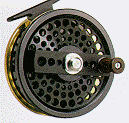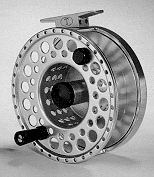
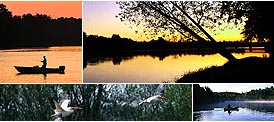
Alligator Hunting: A One of a Kind Experience -
Why They Call it Hunting Instead of Killing -
Florida's Other Crab - by Kris Thoemke
The Waiting Game - by Kris Thoemke
Mounted Memories - by Kris Thoemke
Eco-Touring in Collier County - by Kris Thoemke
Beyond the Largemouth Bass - by Kris Thoemke
Tying One On -- Some thoughts on how to get started tying your own flies -- by Kris Thoemke
The Big Cypress: Adventures in a Vast Wilderness
Four Strokes on the Water -- The sound of the future for marine outboards is likely to be much quieter --
Birding Big Cypress Swamp and the 10,000 Islands --
Recycling Your Fish -- by Kris Thoemke
Peace, Paddle and Hunt -- by Kris Thoemke
by Kris Thoemke
by Kris Thoemke
-- Kris Thoemke spends the day exploring the Big Cypress National Preserve with Preserve biologist Debra Jansen
by Kris Thoemke
by natural history writer and photographer Jeff Ripple
A Basic Guide to Saltwater Fly Fishing in Southwest Florida
C 1996, Don Phillips
Chapter 4 - Fly Reels
In The Compleat Angler (1653) by Izaak Walton, Cotton writes that"....he that cannot kill a trout of 20 inches long with a 2-hair (2
horse hairs) leader deserves not the name of an angler." In proper
perspective this says a lot about the skills of anglers in that century.
They used 15-18 foot rods, line/leader assemblies of the same
length and no reels! Imagine the skill involved with that 20-inch
trout. Even Walton suggests throwing the rod into the stream after
hooking a really large trout, and somehow retrieving it when the
trout has tired.
Although early sketches show that the Chinese were using crude
reels for fishing in the 13th century, they don't show up in English
literature until the early 18th century (Ustonson in 1726)and these
devices were more like baitcasting reels than today's fly reels. The
first US-made fly reels were made in the early 1800s, but the true
forerunners of today's modern fly reels were made in England by
Hardy (1880's) and in the US by Orvis (1874). The late 19th
century was a significant period in reel technology, with the
development of the first saltwater-resistant reel and handle
counterbalancing by Vom Hofe. I'm appreciative of of A Treasury
of Fly Reels by Jim Brown (1990) for the material in these first two
paragraphs.
Much of current trout fly fishing literature refers to the fly reel as simply a place to store line.
This is certainly an understatement for our fly reels used on the Southwest Florida coast. First,
the reel must be capable of withstanding saltwater corrosion at our high ambient temperatures.
Don't forget that corrosive chemical reactions are usually accelerated at increasing temperatures.
Second, our reels must have a good drag mechanism to put pressure on the hooked fish and bring
him to hand in a reasonably short period of time. Third, these reels must generally be larger than
their freshwater cousins, to store heavier line weights and to store more backing line for larger
and more robust fish species.
Most fly reels cost between $30.and $500, but you generally must spend around $100. and up to
have good saltwater resistance, a good drag system and sufficient line capacity. For good
saltwater corrosion resistance, all reel parts must be manufactured from stainless steel, titanium,
anodized aluminum, fiber/resin composite, plated steel, brass or bronze components. Furthermore,
the coating or plating on aluminum and steel parts must be of high integrity to prevent passivation
or corrosion on areas subject to wear or nicking. The best way for the layman to evaluate the
quality of reel materials is to ask fly fishermen who have used their reels for two or more seasons.
After two years of use, most corrosion problems will begin to show up.
For most saltwater applications, the reel's drag system is the most important feature. The
click-and-pawl drag systems are effective in preventing line snarling from reel overrun, but they
provide little in the way of resistance to tire a large fish. Some anglers like the "singing" of a
click-and-pawl reel when a fish is running while others think it's an unnecessary and noisy feature.
A truly experienced fly fisher can live with a click-and-pawl drag if the reel spool has an exposed
rim that he or she can "palm" to control drag manually. Most of our Southwest Florida fly fishers
however use reels with adjustable disk-type drag mechanisms to control the amount of pressure
that can be applied to a running fish. The requirements of a good drag system are that it should
start up from stationary with a minimum of sticking, operate smoothly at all rates of line
withdrawal, and can be set high enough to tire the fish. All three of these requirements must be
met without the drag exceeding the strength of the leader's weakest point.
The fly reel must have enough capacity to hold the fly line being used, plus up to 15 feet of leader
and 100-300 yards of backing. Most reels come with instructions that will tell you how much
backing you can use with various fly lines. Please keep in mind that different fly line designs will
take up different amounts of reel space (more on this in the next chapter). The reel's capacity is
of course determined by three variables; the outside diameter(OD), the inside diameter(ID) and
the width of the reel spool. The reel (sorry, I couldn't resist that) challenge though is to get a reel
whose spool OD, ID and width are properly matched to your intended fishing application. For
snook, redfish, seatrout, mangrove snapper, mackerel, ladyfish and jack crevalle 100-150 yards of
backing is usually more than enough, because even the largest of these species are not known for
running great distances before tiring. However, large tarpon (as well as bonefish and permit on
Florida's eastern flats) can take out a lot of line before they're ready to give some back and you'll
want to have as much line capacity as practical. Therefore, when selecting a reel for tarpon fly
fishing you must consider line capacity plus the following:
Well, enough about drag and reel size; let's talk about several additional features available on
many saltwater fly reels. First, there's counterweighting. To start with, a reel spool is pretty well
balanced. When the reel handle is assembled however, the spool is decidedly out of balance and a
fast run by a strong fish can make your rod and hand vibrate in a most disconcerting fashion. To
counteract this, most good reels either add another handle, or a weighted button of equivalent
inertia, at 180 degrees opposite the handle to rebalance the spool. This is a desirable reel feature
which doesn't add much to its cost.
Another feature which I consider to be almost essential is to make sure that the reel spool can be
removed and replaced "on the water", with no required tools or loose parts. This feature permits
you to carry several spools, each containing different lines for different fishing situations without
having to buy another entire reel.
Another important reel feature is the addition of gearing to cause the reel spool to rotate more Anti-reversing is another feature which some anglers choose, which permits the fish to take out
line under drag while the reel handle is stationary. What this does in practice is to prevent the fish
from breaking off when you've forgotten to let go of the reel handle. Also, it prevents your
knuckles from getting beat up if you let your free hand drift where it doesn't belong during the run
of a fish. Again, I choose not to use anti-reversing reels, to keep things simple and reduce costs.
If you keep your wits about you (admittedly not the easiest thing when a trophy-sized fish is
jerking you around), broken tippets and bruised knuckles can be avoided.
Regularly, beginning saltwater fly fishermen ask me if they should consider using automatic fly
reels. My immediate and loud answer to this question is , "based on current technology, No! "
Current automatic fly reels, which use a wound spring to retrieve line when you move a lever, are
heavy, have very little line/backing capacity, and are loaded with components which are hard to
get at and subject to salt water corrosion. I'm confident however that within 10 years or so,
someone will develop an automatic fly reel with microelectronic controls and a miniature electric
motor to retrieve slack line. And I see no reason why that product wouldn't serve a useful niche
in our fly fishing bag of tricks. Of course, there will be people who will claim that this level of
technology is unsporting and gives the fisherman an unfair advantage over the fish.
The debate goes on and on as to whether the fly fisherman should operate the reel handle with the
right or left hand. Let me try to put this issue in perspective. Right-handed fly fishermen who
reel with their left hand (that's me) do so because that way their strong arm and hand always
holds the rod, whether they're casting, fighting or landing a fish. Even though I started fishing
with bait casting rods with the reel on top and the handle on the right-hand side, most of my
earliest fishing was with spinning rods/reels where the norm was a left-hand winding handle. And
so I feel very comfortable and coordinated reeling with my left hand, even with very high-speed
retrieves. In comparison, the right-hander who reels with the right hand says that he doesn't mind
switching hands to fight a fish, since he feels much more coordinated reeling with his right hand,
especially at high rates of retrieve. Two of my closest fishing friends are Doug Swisher and Carl
Richards, who have been revolutionizing fishing flies and tactics for over 25 years. They are
close to the same age, are both right-handed, and both are excellent casters and fly fishermen.
And yet Doug reels with the left hand and Carl reels with the right hand. And I'm surely not going
to try to
convince either to change their ways. Thus my recommendation is for you to make sure you buy
a reel that can be reversed to accommodate either left- or right-handed winding and to try both
ways until you find your personal preference. Also, if you ever wish to sell the reel in the future,
the reversible feature will mean more potential customers.
As in other equipment, reels can sometimes malfunction. Often, this is simply due to a screw coming loose. Be sure to have a few appropriate tools with you when you're fishing. Twice in the past year a small screwdriver saved me, and another time a friend, from cutting a fishing trip short.
Next Article - Fly Lines and Leaders
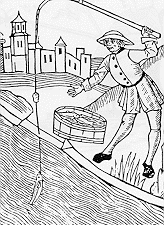
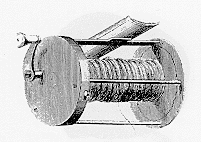
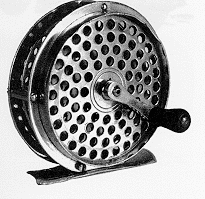
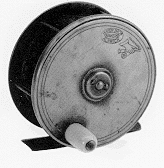
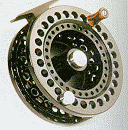 than one revolution, for each revolution of the reel handle. This is a feature which some fly
fishers prefer since it facilitates recovering slack line quickly. Unfortunately, such multiplier reels
also give the fish a mechanical advantage under those conditions where you are reeling him in
without pumping the rod to create periodic slack. I personally don't own any multipliers, but if
you're willing to pay a few extra bucks for the fast retrieve features, I certainly wouldn't try to
talk you out of that choice.
than one revolution, for each revolution of the reel handle. This is a feature which some fly
fishers prefer since it facilitates recovering slack line quickly. Unfortunately, such multiplier reels
also give the fish a mechanical advantage under those conditions where you are reeling him in
without pumping the rod to create periodic slack. I personally don't own any multipliers, but if
you're willing to pay a few extra bucks for the fast retrieve features, I certainly wouldn't try to
talk you out of that choice.
